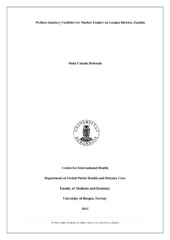| dc.description.abstract | Introduction: Welfare sanitary facilities are important for the health, safety and well-being of workers. According to the literature, workers world-wide, and Zambia in particular, might be exposed to poor provisions of welfare sanitary facilities in workplaces. This study therefore aimed to assess provision of welfare sanitary facilities for market traders of Lusaka district and their perception on the provided facilities. Welfare sanitary facilities are important for the health of both the traders and their customers. Methods and materials: A cross sectional study was carried out in Lusaka district that involved 12 markets run by the city council. Data on provided welfare sanitary facilities and perception of market traders on the provided facilities were collected through interviews of 12 market heads and 386 market traders using systematic interview guides and workplace observations using a checklist. In addition, a total of 22 samples of water were collected: two samples from each market to determine the bacteriological standards of drinking water. A total of 44 water analysis tests were conducted using membrane filtration technique, 22 for Total Coliform and another 22 for Faecal Coliform. SPSS was used both in data entry and analysis. Descriptive statistics such as frequencies, proportions and means were obtained from the analysis. Tests of associations between variables were also conducted using Chi-square, Fisher's exact test and ANOVA. Results: The study established that welfare sanitary facilities were not provided in all markets as one out of 12 markets did not have any welfare sanitary facilities for traders. The majority of the markets did not comply with the laws of Zambia in terms of adequacy of toilets (11); hand washing facilities (10) and cleanliness (six). None of the markets complied with privacy of facilities and siting of sanitary facilities at appropriate distance from the stalls. Not all water provided for market traders complied with the Food and Drugs Act of Zambia's requirements as water from two markets was contaminated with Faecal and Total coliform. Most of the traders perceived facilities as not being up to standard in terms of adequacy of toilets (73.1%); hand washing facilities (60.1%), cleanliness (78.2%) and privacy (72.0%). Most of the traders (69.2%) only used the facilities because they did not have any other option. Conclusion: There is generally poor provision of welfare sanitary facilities for market traders in Lusaka district, Zambia. These results call for action by the various stakeholders to ensure that the health of the traders is protected. | en_US |
